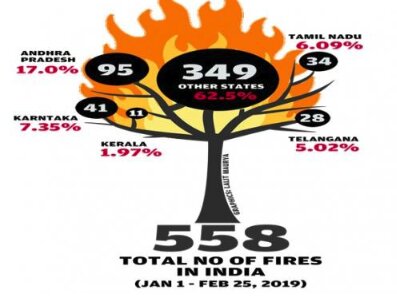Biodiversity & Environment
Forest Inferno
- 14 May 2019
- 6 min read
More than 900 hectares of forest land has been gutted in wild-fire in Uttarakhand. The number of forest fires shot up to 14,107 from 4,225 between November 2018 and February 2019, according to the Real-Time Forest Alert System of the Forest Survey of India (FSI).
Primary Causes of Wildfires
- Human Causes
- 90% of all wildfires are caused by humans.
- Human acts of carelessness such as leaving campfires unattended and negligent discarding of cigarette butts result in wildfire disasters every year.
- Accidents, deliberate acts of arson, burning of debris, and fireworks are the other substantial causes of wildfires.
- Natural Causes
- Lightning: A fairly good number of wildfires are triggered by lightning.
- Volcanic eruption: Hot magma in the earth’s crust is usually expelled out as lava during a volcanic eruption. The hot lava then flows into nearby fields or lands to start wildfires.
- Temperature: High atmospheric temperatures and dryness offer favourable conditions for a fire to start.
- Climate change is causing a gradual but highly significant increasing trend in surface air temperatures, and it leads to record-breaking extremes in many areas when it interacts with the normal periodic warming associated with an El Nino.
- An important climate variable for fire is vapour pressure deficit. It is a measure that combines temperature and relative humidity near the surface.
- Warmer temperatures and lower humidity cause vapour pressure deficit to increase which can dry fuels rapidly and allow fires to grow very fast
Types of Wildland Fires
There are three basic types of forest fires:
- Crown fires burn trees up their entire length to the top. These are the most intense and dangerous wildland fires.
- Surface fires burn only surface litter and duff. These are the easiest fires to put out and cause the least damage to the forest.
- Ground fires (sometimes called underground or subsurface fires) occur in deep accumulations of humus, peat and similar dead vegetation that become dry enough to burn. These fires move very slowly, but can become difficult to fully put out, or suppress. Occasionally, especially during prolonged drought, such fires can smoulder all winter underground and then emerge at the surface again in spring.
The Effects of Fire on Ecosystems
- Mosaic Patterns: Wildland fires create a mixture of totally burned, partially burned, and unburned sections called a burn mosaic. The burn mosaic results in varied regrowth rates that create a vegetation mosaic.
- Soil Conditions: Wildland fires can be both a detriment and a benefit to soil. The soil can become more nutrient-rich after a fire due to the high mineral content of the ash and charcoal and also due to the warm, moist conditions that increase microbial activity. The intense heat can also cause soil particles to become water-repellant, causing rainwater to run off. As the water runs off it can carry soil particles with it and lead to erosion.
- Climate Related:
- ‘Black carbon’ from the smog and ash covers the glaciers, making them more prone to melting. In India, the glaciers most likely to be affected by this are the ones situated at low altitudes, like Gangotri, Milam, Sundardunga, Newla and Cheepa.
- Water in the rivers is also likely to get much polluted from the effects of this black carbon.
- In 2016, forest fires have raised average temperatures across northern India by 0.2 degree Celsius, which had a bad effect on monsoons.
Mitigation Strategies
- Technology
- FSI has begun the development of systems for early warning and fire danger rating, and these efforts should be continued.
- Digitization of management boundaries by the state forest departments should be completed, so that the FSI can more accurately determine which fires to report and to whom.
- Fire alert systems can also be improved by integrating ground-based detection with the satellite-based alert systems.
- Community Engagement
- Sensitization of communities should be done to ensure that fire is used responsibly in a way that promotes forest health, while seeking to avoid damaging and out-of-control fires.
- Provision of training should extend beyond state-managed forests to community institutions in regions such as the Northeast, where communities are responsible for managing most of the forest estate.




